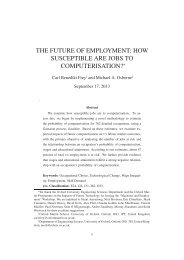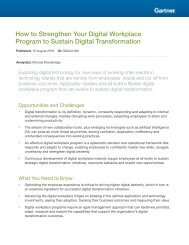THE FUTURE OF EMPLOYMENT: HOW SUSCEPTIBLE ARE JOBS TO COMPUTERIZATION?
We examine how susceptible jobs are to computerization. To assess this, we begin by implementing a novel methodology to estimate the probability of computerization for 702 detailed occupations, using a Gaussian process classifier. Based on these estimates, we examine expected impacts of future computerization on US labor market outcomes, with the primary objective of analyzing the number of jobs at risk and the relationship between an occupation’s probability of computerization, wages and educational attainment. According to our estimates, about 47 percent of total US employment is at risk. We further provide evidence that wages and educational attainment exhibit a strong negative relationship with an occupation’s probability of computerization.
We examine how susceptible jobs are to computerization. To assess this, we begin by implementing a novel methodology to estimate the probability of computerization for 702 detailed occupations, using a Gaussian process classifier. Based on these estimates, we examine expected impacts of future computerization on US labor market outcomes, with the primary objective of analyzing the number of jobs at risk and the relationship between an occupation’s probability of computerization, wages and educational attainment. According to our estimates, about 47 percent of total US employment is at risk. We further provide evidence that wages and educational attainment exhibit a strong negative relationship with an occupation’s probability of computerization.
Create successful ePaper yourself
Turn your PDF publications into a flip-book with our unique Google optimized e-Paper software.
Probability of<br />
Computerisation<br />
1<br />
Dishwasher<br />
Event<br />
Planner<br />
Public<br />
Relations<br />
0<br />
0 100<br />
Social Intelligence<br />
Probability of<br />
Computerisation<br />
1<br />
Court Clerk<br />
Fashion<br />
Designer<br />
0<br />
Biologist<br />
0 100<br />
Creativity<br />
Probability of<br />
Computerisation<br />
1<br />
Telemarketer<br />
Boilermaker<br />
0<br />
Surgeon<br />
0 100<br />
Perception and manipulation<br />
FIGURE I. A sketch of how the probability of computerisation might vary as a function of<br />
bottleneck variables.<br />
non-susceptible task characteristics.<br />
IV.<br />
MEASURING <strong>THE</strong> <strong>EMPLOYMENT</strong> IMPACT <strong>OF</strong> COMPUTERISATION<br />
IV.A. Data sources and implementation strategy<br />
To implement the above described methodology, we rely on O∗NET, an online<br />
service developed for the US Department of Labor. The 2010 version of O∗NET<br />
contains information on 903 detailed occupations, most of which correspond<br />
closely to the Labor Department’s Standard Occupational Classification (SOC).<br />
The O∗NET data was initially collected from labour market analysts, and has<br />
since been regularly updated by surveys of each occupation’s worker population<br />
and related experts, to provide up-to-date information on occupations as they<br />
evolve over time. For our purposes, an important feature of O∗NET is that it<br />
defines the key features of an occupation as a standardised and measurable set<br />
of variables, but also provides open-ended descriptions of specific tasks to each<br />
occupation. This allows us to: (a) objectively rank occupations according to<br />
the mix of knowledge, skills, and abilities they require; and (b) subjectively<br />
categorise them based on the variety of tasks they involve.<br />
The close SOC correspondence of O∗NET allows us to link occupational<br />
characteristics to 2010 Bureau of Labor Statistics (BLS) employment and wage<br />
data. While the O∗NET occupational classification is somewhat more detailed,<br />
distinguishing between Auditors and Accountants, for example, we aggregate<br />
these occupations to correspond to the six-digit 2010 SOC system, for which<br />
employment and wage figures are reported. To obtain unique O∗NET variables<br />
corresponding to the six-digit SOC classification, we used the mean of<br />
28





